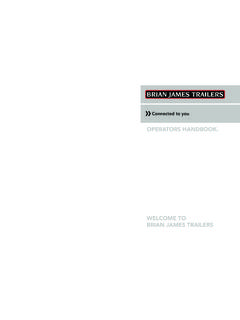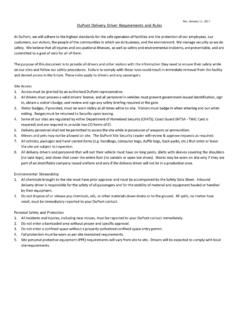Transcription of IMO STANDARD MARINE COMMUNICATION …
1 NAV 46 INTERNATIONAL MARITIME ORGANIZATION IMO E SUB-COMMITTEE ON SAFETY OF NAVIGATION 46th session Agenda item 9 NAV 46 4 April 2000 Original: ENGLISH & RIJEKA COLLEGE OF MARITIME STUDIES IMO STANDARD MARINE COMMUNICATION phrases (SMCP) Rijeka, September 2000 NAV 46 ANNEX Page 2 FOREWORD As navigational and safety communications from ship to shore and vice versa, ship to ship , and on board ships must be precise, simple and unambiguous, so as to avoid confusion and error, there is a need to standardize the language used. This is of particular importance in the light of the increasing number of internationally trading vessels with crews speaking many different languages since problems of COMMUNICATION may cause misunderstandings leading to dangers to the vessel, the people on board and the environment.
2 In 1973 the IMO Maritime Safety Committee agreed at its twenty-seventh session that, where language difficulties arise, a common language should be used for navigational purposes and that language should be English. In consequence the STANDARD MARINE Navigational Vocabulary (SMNV) was developed, adopted in 1977 and amended in 1985. In 1992 the IMO Maritime Safety Committee at its sixtieth session instructed the IMO Sub-Committee on Safety of Navigation to develop a more comprehensive standardized safety language than the SMNV, 1985, taking into account the changing conditions in modern seafaring and covering all major safety-related verbal communications. At its sixty-eighth session in 1997 the IMO Maritime Safety Committee adopted the Draft STANDARD MARINE COMMUNICATION phrases (SMCP) developed by the IMO Sub-Committee on Safety of Navigation.
3 The Draft SMCP, following international trials, was amended at the forty-sixth session of this Sub-Committee and final consideration given at the IMO Maritime Safety Committee at its [.. ] session in the light of remarks received by the Organization. The SMCP was adopted by the IMO Assembly in [ .. ]as resolution A.( [.. ] ) . Under the International Convention on standards of Training, Certification and Watchkeeping for Seafarers, 1978, as revised 1995, the ability to understand and use the SMCP is required for the certification of officers in charge of a navigational watch on ships of 500 gross tonnage or more. NAV 46 ANNEX Page 3 IMO STANDARD MARINE COMMUNICATION phrases CONTENTS DESCRIPTION PAGE INTRODUCTION 9 1 Position of the SMCP in maritime practice 2 Organization of the SMCP 3 Position of the SMCP in Maritime Education and Training 4 Basic communicative features 5 Typographical conventions GENERAL 11 1 Procedure 2 Spelling 3 Message Markers 4 Responses 5 Distress / urgency / safety signals 6 STANDARD organizational phrases 7 Corrections 8 Readiness 9 Repetition 10 Numbers 11 Positions 12 Bearings 13 Courses 14 Distances 15 Speed 16 Time 17 Geographical names 18 Ambiguous words GLOSSARY 17 1 General terms 2 VTS special terms STANDARD MARINE COMMUNICATION phrases
4 PART A 29 AI EXTERNAL COMMUNICATION phrases 29 AI/1 Distress Communications 29 Distress traffic 29 NAV 46 ANNEX Page 4 .1 Fire, explosion .2 Flooding .3 Collision .4 Grounding .5 List, danger of capsizing .6 Sinking .7 Disabled and adrift .8 Armed attack / piracy .9 Undesignated distress .10 Abandoning vessel .11 Person overboard Search and Rescue communications 32 .1 SAR communications (specifying or supplementary to ) .2 Acknowledgement and / or relay of SAR-messages .3 Performing / co-ordinating SAR-operations .4 Finishing with SAR-operations AI/1 .3 Requesting Medical Assistance 34 AI/2 Urgency traffic 35 Safety of a vessel (other than distress) .1 Technical failure .2 Cargo .3 Ice damage AI/3 Safety Communications 36 Meteorological and hydrological conditions 36.
5 1 Winds, storms, tropical storms; sea state .2 Restricted visibility .3 Ice .4 Abnormal tides Navigational warnings involving 38 .1 Land- or seamarks .2 Drifting objects .3 Electronic navigational aids .4 Seabottom characteristics, wrecks .5 Miscellaneous . Cable, pipe and seismic / hydrographic operations . Diving operations, tows, dredging operations . Tanker transhipment . Off-shore installations, rig moves . Defective locks or bridges . Military operations . Fishery NAV 46 ANNEX Page 5 Environmental protection communications 40 AI/4 Pilotage 40 Pilot request 40 Embarking / disembarking pilot 41 Tug request 41 AI/5 Specials 42 Helicopter operations 42 Ice-breaker operations 42.
6 1 Ice-breaker request .2 Ice-breaker assistance for convoy .3 Iice-breaker assistance in close-coupled towing AI/6 Vessel Traffic Service (VTS) STANDARD phrases 43 phrases for acquiring and providing data for a traffic image 46 .1 Acquiring and providing routine traffic data .2 Acquiring and providing distress traffic data phrases for providing VTS services 47 .1 Information service . Navigational warnings . Navigational information . Traffic information . Route information . Hydrographic information . Electronic navigational aids information . Meteorological warnings . Meteorological information . Meteorological questions and answers .2 Navigational assistance service . Request and identification . Position . Course .3 Traffic organization service.
7 Clearance, forward planning . Anchoring . Arrival, berthing and departure . Enforcement . Avoiding dangerous situations, providing safe movements . Canal and lock operations Handing over to another VTS 54 phrases for COMMUNICATION with emergency services and allied services 54 .1 Emergency services (SAR, fire fighting, pollution fighting) .2 Tug services .3 Pilot request NAV 46 ANNEX Page 6 .4 Embarking / disembarking pilot Appendix to AI External COMMUNICATION phrases 56 STANDARD GMDSS Messages 1 STANDARD Distress Message .1 Structure .2 Example 2 STANDARD Urgency Message .1 Structure .2 Example 3 STANDARD Safety Message .1 Structure .2 Example AII ON-BOARD COMMUNICATION phrases (A) 57 AII/1 STANDARD Wheel Orders 58 AII/2 STANDARD Engine Orders 59 AII/3 Pilot on the Bridge 59 Propulsion system 59 Manoeuvring 60 Radar 60 Draft and air draft 61 Anchoring 61.
8 1 Going to anchor .2 Leaving the anchorage Tug assistance 62 Berthing and unberthing 63 .1 General .2 Berthing .3 Unberthing STANDARD MARINE COMMUNICATION phrases PART B 65 B ON-BOARD COMMUNICATION phrases (B) 65 B1 Operative Shiphandling 65 B1/1 Handing over the watch 65 B1 Briefing on position, movement and draft 65 .1 Position NAV 46 ANNEX Page 7 .2 Movements .3 Draft B1 Briefing on traffic situation in the area 66 B1 Briefing on navigational aids and equipment status 66 B1 Briefing on radiocommunications 66 B1 Briefing on meteorological conditions 67 B1 Briefing on standing orders and bridge organization 67 B1 Briefing on special navigational events 68 B1 Briefing on temperatures, pressures and soundings 68 B1 Briefing on operation of main engine and auxiliary equipment 68 B1 Briefing on pumping of fuel, ballast water, etc.
9 68 B1 Briefing on special machinery events and repairs 69 B1 Briefing on record keeping 69 B1 Handing and taking over the watch 69 B1/2 Trim, list and stability 69 B2 Safety on Board 70 B2/1 General Activities 70 B2 Raising alarm 70 B2 Briefing crew and passengers 70 B2 Checking status of escape routes 71 B2 Checking status of lifeboats / liferafts 71 B2 Ordering evacuation 72 B2 Roll call 73 B2 Ordering abandon vessel 73 B2 In-boat procedures 73 B2/2 Occupational Safety 75 B2 Instruction 75 B2 Practical occupational safety 75 B2 Occupational accidents 76 B2/3 Fire Protection and Fire Fighting 76 NAV 46 ANNEX Page 8 B2 Fire protection 76.
10 1 Checking status of equipment B2 Fire fighting and drills 78 .1 Reporting fire .2 Reporting readiness for action .3 Orders for fire fighting .4 Cancellation of alarm B2/4 Damage Control 80 B2 Checking equipment status and drills 80 B2 Damage control activities 81 .1 Reporting flooding .2 Reporting readiness for action .3 Orders for damage control .4 Cancellation of alarm B2/5 Grounding 83 B2 Reporting grounding and ordering actions 83 B2 Reporting damage 83 B2 Orders for refloating 84 B2 Checking seaworthiness 85 B2/6 Search and Rescue On-board Activities 85 B2 Checking equipment status 86 B2 Person-overboard activities B2 Rescue operation - reporting readiness for assistance 88 B2 Conducting search 88 B2 Rescue activities 89 B2 Finishing with search and rescue operations 89 B3 Cargo and Cargo Handling 89 B3/1 Cargo Handling 89 B3 Loading and unloading 89.






